University HRM Case Study: Workplace Diversity Issues in Amazon
VerifiedAdded on 2022/11/26
|12
|3351
|94
Case Study
AI Summary
This case study examines the issues of workplace diversity within Amazon, focusing on the challenges related to gender and ethnic representation. The paper highlights the imbalance in the male-female employee ratio, particularly in management positions, and the underrepresentation of various ethnic groups within the workforce. It explores potential causes for these issues, including ineffective HRM practices, a lack of skill-building opportunities for women, and difficulties in integrating employees from diverse ethnic backgrounds. The study then recommends strategies to improve diversity, such as empowering women through training and development, and providing cultural training for employees from ethnic groups. The overall goal is to improve Amazon's organizational culture and enhance its performance by fostering a more inclusive and diverse workplace. This assignment is contributed by a student to be published on the website Desklib. Desklib is a platform which provides all the necessary AI based study tools for students.
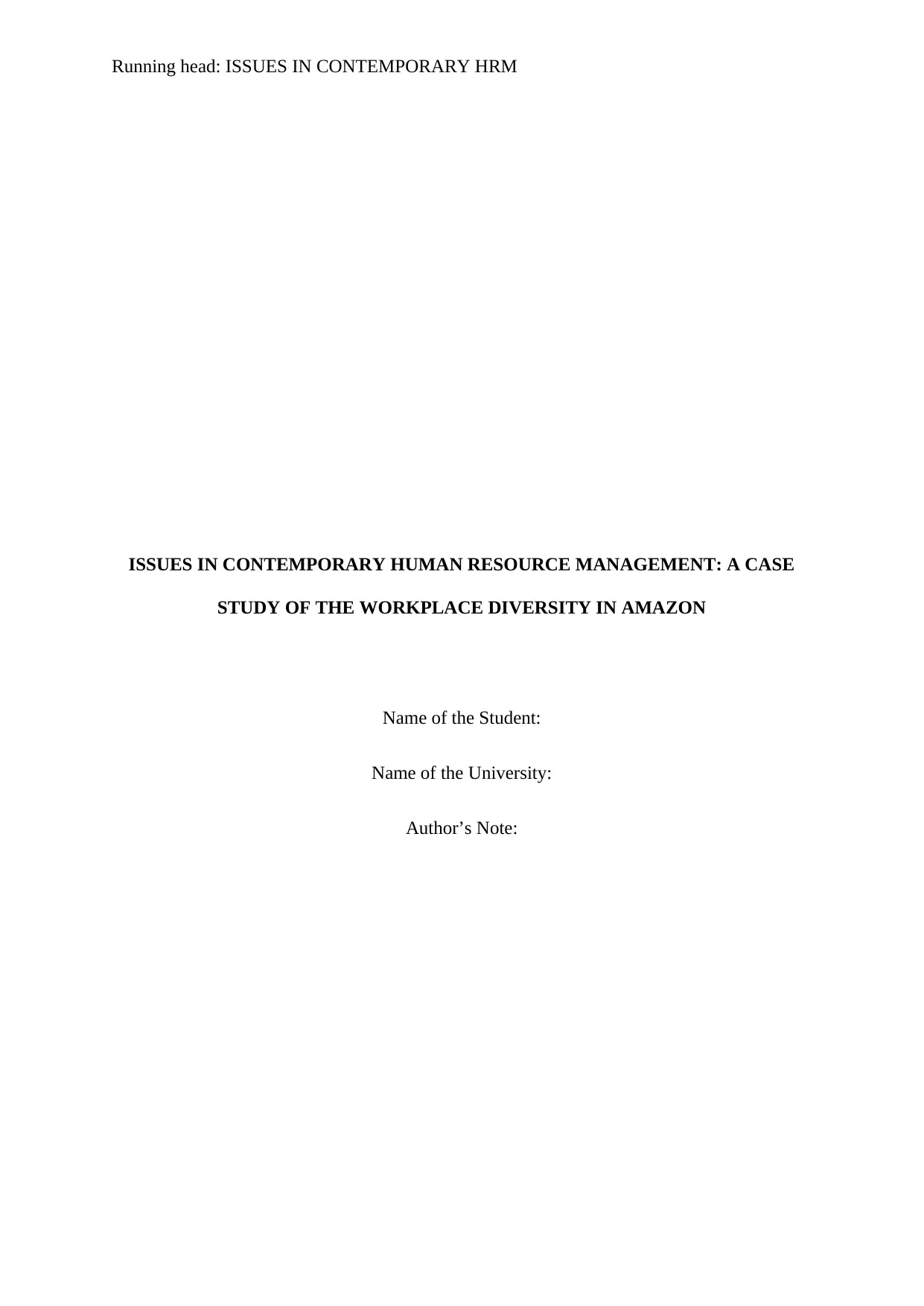
Running head: ISSUES IN CONTEMPORARY HRM
ISSUES IN CONTEMPORARY HUMAN RESOURCE MANAGEMENT: A CASE
STUDY OF THE WORKPLACE DIVERSITY IN AMAZON
Name of the Student:
Name of the University:
Author’s Note:
ISSUES IN CONTEMPORARY HUMAN RESOURCE MANAGEMENT: A CASE
STUDY OF THE WORKPLACE DIVERSITY IN AMAZON
Name of the Student:
Name of the University:
Author’s Note:
Paraphrase This Document
Need a fresh take? Get an instant paraphrase of this document with our AI Paraphraser
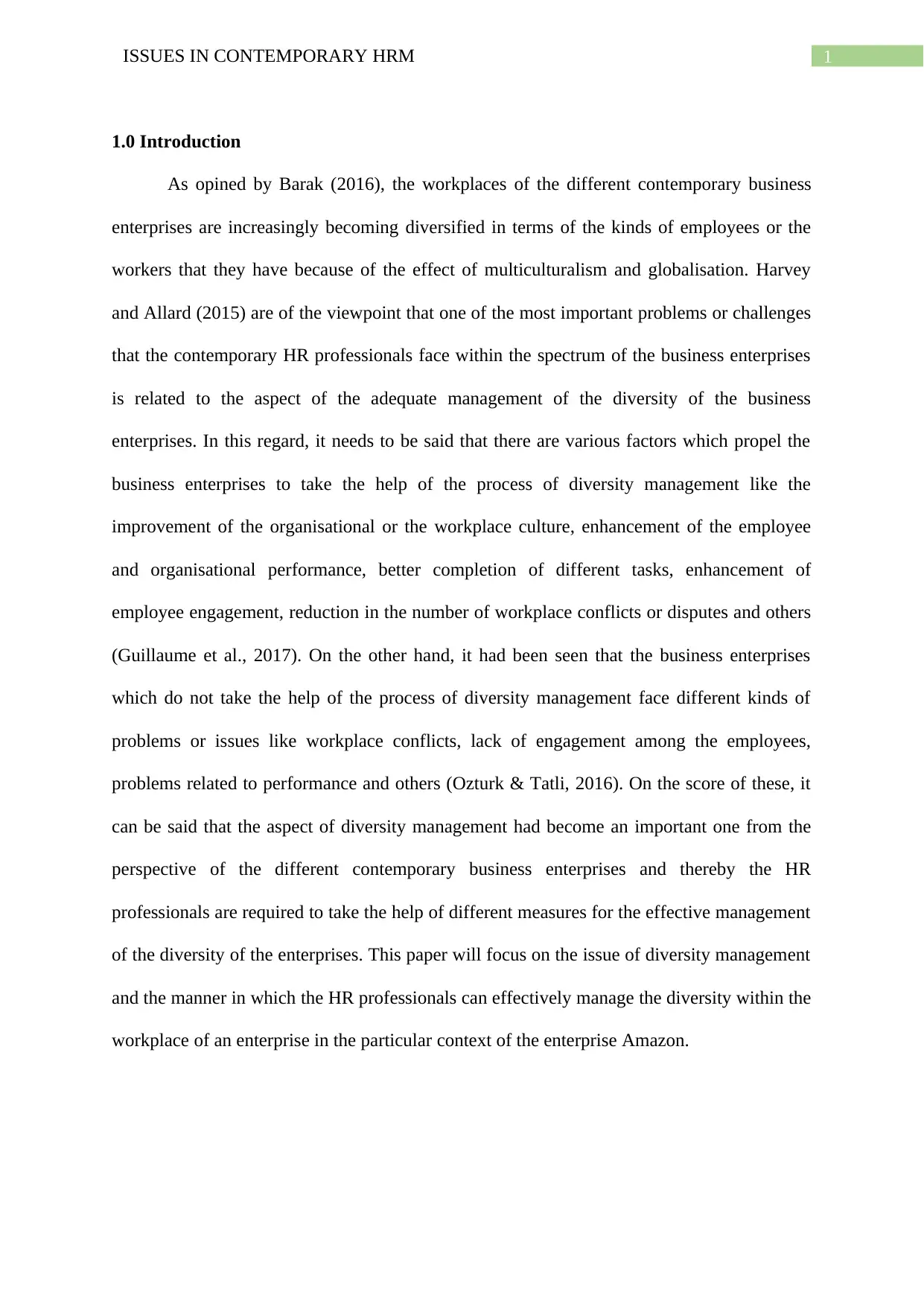
1ISSUES IN CONTEMPORARY HRM
1.0 Introduction
As opined by Barak (2016), the workplaces of the different contemporary business
enterprises are increasingly becoming diversified in terms of the kinds of employees or the
workers that they have because of the effect of multiculturalism and globalisation. Harvey
and Allard (2015) are of the viewpoint that one of the most important problems or challenges
that the contemporary HR professionals face within the spectrum of the business enterprises
is related to the aspect of the adequate management of the diversity of the business
enterprises. In this regard, it needs to be said that there are various factors which propel the
business enterprises to take the help of the process of diversity management like the
improvement of the organisational or the workplace culture, enhancement of the employee
and organisational performance, better completion of different tasks, enhancement of
employee engagement, reduction in the number of workplace conflicts or disputes and others
(Guillaume et al., 2017). On the other hand, it had been seen that the business enterprises
which do not take the help of the process of diversity management face different kinds of
problems or issues like workplace conflicts, lack of engagement among the employees,
problems related to performance and others (Ozturk & Tatli, 2016). On the score of these, it
can be said that the aspect of diversity management had become an important one from the
perspective of the different contemporary business enterprises and thereby the HR
professionals are required to take the help of different measures for the effective management
of the diversity of the enterprises. This paper will focus on the issue of diversity management
and the manner in which the HR professionals can effectively manage the diversity within the
workplace of an enterprise in the particular context of the enterprise Amazon.
1.0 Introduction
As opined by Barak (2016), the workplaces of the different contemporary business
enterprises are increasingly becoming diversified in terms of the kinds of employees or the
workers that they have because of the effect of multiculturalism and globalisation. Harvey
and Allard (2015) are of the viewpoint that one of the most important problems or challenges
that the contemporary HR professionals face within the spectrum of the business enterprises
is related to the aspect of the adequate management of the diversity of the business
enterprises. In this regard, it needs to be said that there are various factors which propel the
business enterprises to take the help of the process of diversity management like the
improvement of the organisational or the workplace culture, enhancement of the employee
and organisational performance, better completion of different tasks, enhancement of
employee engagement, reduction in the number of workplace conflicts or disputes and others
(Guillaume et al., 2017). On the other hand, it had been seen that the business enterprises
which do not take the help of the process of diversity management face different kinds of
problems or issues like workplace conflicts, lack of engagement among the employees,
problems related to performance and others (Ozturk & Tatli, 2016). On the score of these, it
can be said that the aspect of diversity management had become an important one from the
perspective of the different contemporary business enterprises and thereby the HR
professionals are required to take the help of different measures for the effective management
of the diversity of the enterprises. This paper will focus on the issue of diversity management
and the manner in which the HR professionals can effectively manage the diversity within the
workplace of an enterprise in the particular context of the enterprise Amazon.
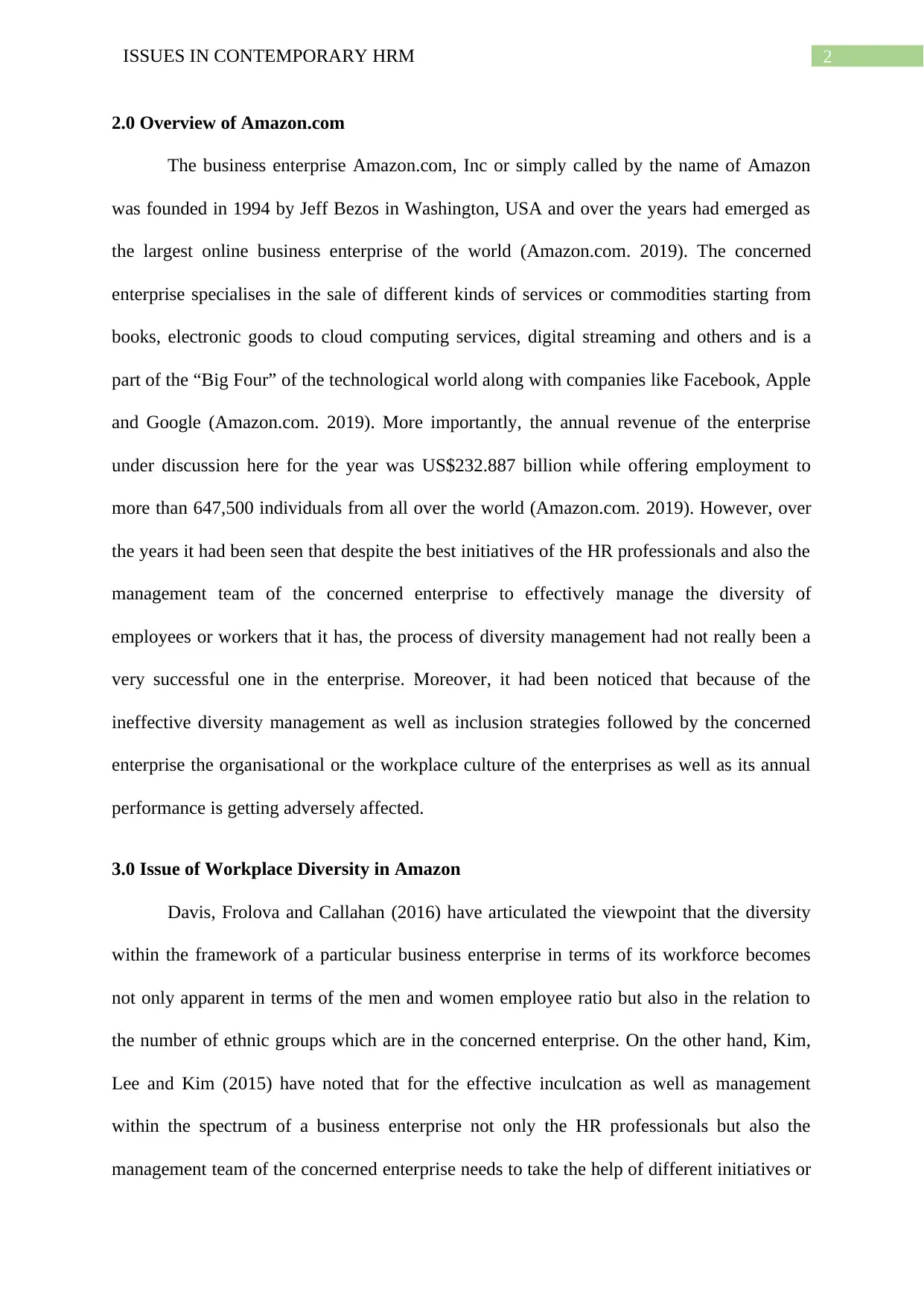
2ISSUES IN CONTEMPORARY HRM
2.0 Overview of Amazon.com
The business enterprise Amazon.com, Inc or simply called by the name of Amazon
was founded in 1994 by Jeff Bezos in Washington, USA and over the years had emerged as
the largest online business enterprise of the world (Amazon.com. 2019). The concerned
enterprise specialises in the sale of different kinds of services or commodities starting from
books, electronic goods to cloud computing services, digital streaming and others and is a
part of the “Big Four” of the technological world along with companies like Facebook, Apple
and Google (Amazon.com. 2019). More importantly, the annual revenue of the enterprise
under discussion here for the year was US$232.887 billion while offering employment to
more than 647,500 individuals from all over the world (Amazon.com. 2019). However, over
the years it had been seen that despite the best initiatives of the HR professionals and also the
management team of the concerned enterprise to effectively manage the diversity of
employees or workers that it has, the process of diversity management had not really been a
very successful one in the enterprise. Moreover, it had been noticed that because of the
ineffective diversity management as well as inclusion strategies followed by the concerned
enterprise the organisational or the workplace culture of the enterprises as well as its annual
performance is getting adversely affected.
3.0 Issue of Workplace Diversity in Amazon
Davis, Frolova and Callahan (2016) have articulated the viewpoint that the diversity
within the framework of a particular business enterprise in terms of its workforce becomes
not only apparent in terms of the men and women employee ratio but also in the relation to
the number of ethnic groups which are in the concerned enterprise. On the other hand, Kim,
Lee and Kim (2015) have noted that for the effective inculcation as well as management
within the spectrum of a business enterprise not only the HR professionals but also the
management team of the concerned enterprise needs to take the help of different initiatives or
2.0 Overview of Amazon.com
The business enterprise Amazon.com, Inc or simply called by the name of Amazon
was founded in 1994 by Jeff Bezos in Washington, USA and over the years had emerged as
the largest online business enterprise of the world (Amazon.com. 2019). The concerned
enterprise specialises in the sale of different kinds of services or commodities starting from
books, electronic goods to cloud computing services, digital streaming and others and is a
part of the “Big Four” of the technological world along with companies like Facebook, Apple
and Google (Amazon.com. 2019). More importantly, the annual revenue of the enterprise
under discussion here for the year was US$232.887 billion while offering employment to
more than 647,500 individuals from all over the world (Amazon.com. 2019). However, over
the years it had been seen that despite the best initiatives of the HR professionals and also the
management team of the concerned enterprise to effectively manage the diversity of
employees or workers that it has, the process of diversity management had not really been a
very successful one in the enterprise. Moreover, it had been noticed that because of the
ineffective diversity management as well as inclusion strategies followed by the concerned
enterprise the organisational or the workplace culture of the enterprises as well as its annual
performance is getting adversely affected.
3.0 Issue of Workplace Diversity in Amazon
Davis, Frolova and Callahan (2016) have articulated the viewpoint that the diversity
within the framework of a particular business enterprise in terms of its workforce becomes
not only apparent in terms of the men and women employee ratio but also in the relation to
the number of ethnic groups which are in the concerned enterprise. On the other hand, Kim,
Lee and Kim (2015) have noted that for the effective inculcation as well as management
within the spectrum of a business enterprise not only the HR professionals but also the
management team of the concerned enterprise needs to take the help of different initiatives or
⊘ This is a preview!⊘
Do you want full access?
Subscribe today to unlock all pages.

Trusted by 1+ million students worldwide
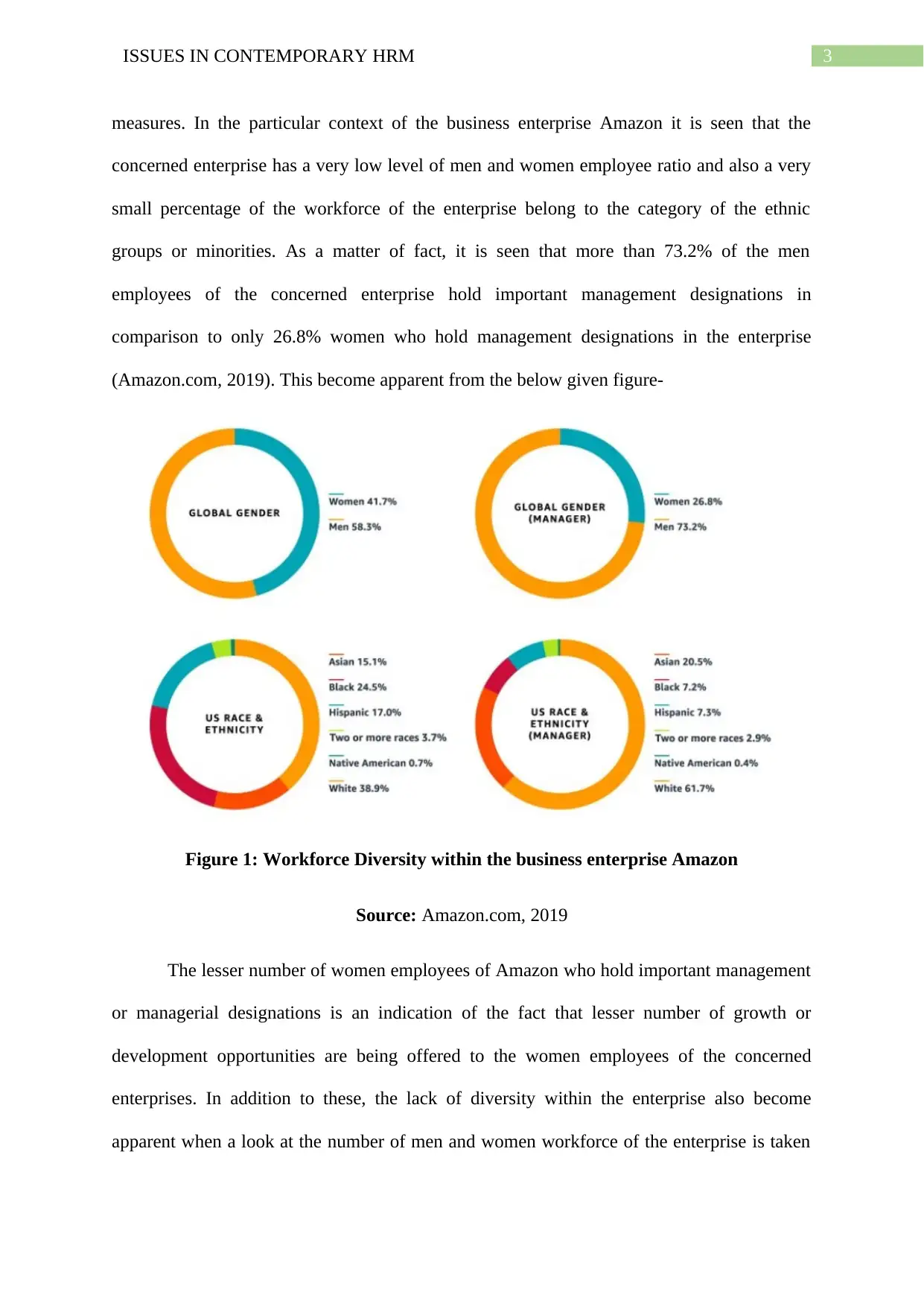
3ISSUES IN CONTEMPORARY HRM
measures. In the particular context of the business enterprise Amazon it is seen that the
concerned enterprise has a very low level of men and women employee ratio and also a very
small percentage of the workforce of the enterprise belong to the category of the ethnic
groups or minorities. As a matter of fact, it is seen that more than 73.2% of the men
employees of the concerned enterprise hold important management designations in
comparison to only 26.8% women who hold management designations in the enterprise
(Amazon.com, 2019). This become apparent from the below given figure-
Figure 1: Workforce Diversity within the business enterprise Amazon
Source: Amazon.com, 2019
The lesser number of women employees of Amazon who hold important management
or managerial designations is an indication of the fact that lesser number of growth or
development opportunities are being offered to the women employees of the concerned
enterprises. In addition to these, the lack of diversity within the enterprise also become
apparent when a look at the number of men and women workforce of the enterprise is taken
measures. In the particular context of the business enterprise Amazon it is seen that the
concerned enterprise has a very low level of men and women employee ratio and also a very
small percentage of the workforce of the enterprise belong to the category of the ethnic
groups or minorities. As a matter of fact, it is seen that more than 73.2% of the men
employees of the concerned enterprise hold important management designations in
comparison to only 26.8% women who hold management designations in the enterprise
(Amazon.com, 2019). This become apparent from the below given figure-
Figure 1: Workforce Diversity within the business enterprise Amazon
Source: Amazon.com, 2019
The lesser number of women employees of Amazon who hold important management
or managerial designations is an indication of the fact that lesser number of growth or
development opportunities are being offered to the women employees of the concerned
enterprises. In addition to these, the lack of diversity within the enterprise also become
apparent when a look at the number of men and women workforce of the enterprise is taken
Paraphrase This Document
Need a fresh take? Get an instant paraphrase of this document with our AI Paraphraser
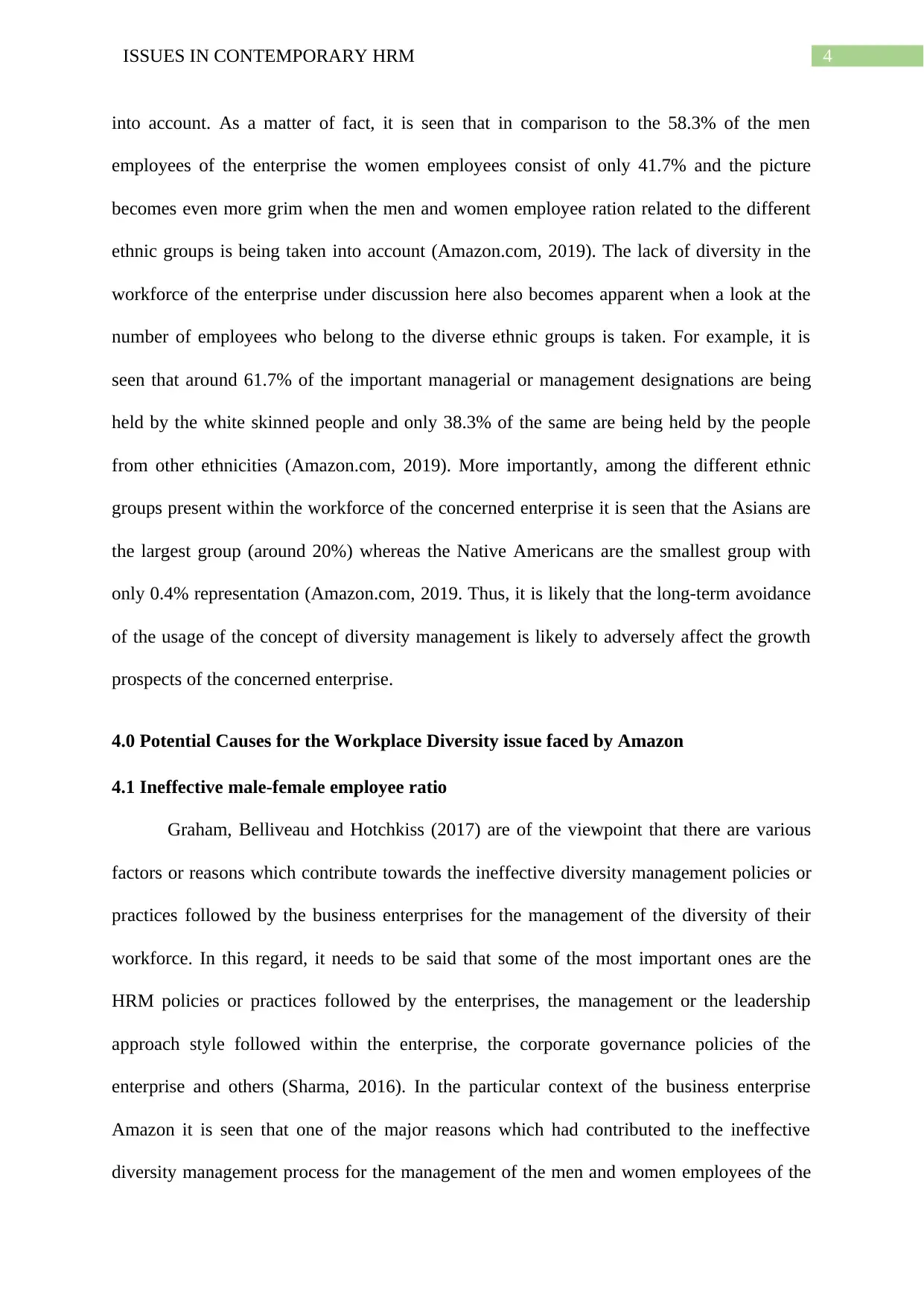
4ISSUES IN CONTEMPORARY HRM
into account. As a matter of fact, it is seen that in comparison to the 58.3% of the men
employees of the enterprise the women employees consist of only 41.7% and the picture
becomes even more grim when the men and women employee ration related to the different
ethnic groups is being taken into account (Amazon.com, 2019). The lack of diversity in the
workforce of the enterprise under discussion here also becomes apparent when a look at the
number of employees who belong to the diverse ethnic groups is taken. For example, it is
seen that around 61.7% of the important managerial or management designations are being
held by the white skinned people and only 38.3% of the same are being held by the people
from other ethnicities (Amazon.com, 2019). More importantly, among the different ethnic
groups present within the workforce of the concerned enterprise it is seen that the Asians are
the largest group (around 20%) whereas the Native Americans are the smallest group with
only 0.4% representation (Amazon.com, 2019. Thus, it is likely that the long-term avoidance
of the usage of the concept of diversity management is likely to adversely affect the growth
prospects of the concerned enterprise.
4.0 Potential Causes for the Workplace Diversity issue faced by Amazon
4.1 Ineffective male-female employee ratio
Graham, Belliveau and Hotchkiss (2017) are of the viewpoint that there are various
factors or reasons which contribute towards the ineffective diversity management policies or
practices followed by the business enterprises for the management of the diversity of their
workforce. In this regard, it needs to be said that some of the most important ones are the
HRM policies or practices followed by the enterprises, the management or the leadership
approach style followed within the enterprise, the corporate governance policies of the
enterprise and others (Sharma, 2016). In the particular context of the business enterprise
Amazon it is seen that one of the major reasons which had contributed to the ineffective
diversity management process for the management of the men and women employees of the
into account. As a matter of fact, it is seen that in comparison to the 58.3% of the men
employees of the enterprise the women employees consist of only 41.7% and the picture
becomes even more grim when the men and women employee ration related to the different
ethnic groups is being taken into account (Amazon.com, 2019). The lack of diversity in the
workforce of the enterprise under discussion here also becomes apparent when a look at the
number of employees who belong to the diverse ethnic groups is taken. For example, it is
seen that around 61.7% of the important managerial or management designations are being
held by the white skinned people and only 38.3% of the same are being held by the people
from other ethnicities (Amazon.com, 2019). More importantly, among the different ethnic
groups present within the workforce of the concerned enterprise it is seen that the Asians are
the largest group (around 20%) whereas the Native Americans are the smallest group with
only 0.4% representation (Amazon.com, 2019. Thus, it is likely that the long-term avoidance
of the usage of the concept of diversity management is likely to adversely affect the growth
prospects of the concerned enterprise.
4.0 Potential Causes for the Workplace Diversity issue faced by Amazon
4.1 Ineffective male-female employee ratio
Graham, Belliveau and Hotchkiss (2017) are of the viewpoint that there are various
factors or reasons which contribute towards the ineffective diversity management policies or
practices followed by the business enterprises for the management of the diversity of their
workforce. In this regard, it needs to be said that some of the most important ones are the
HRM policies or practices followed by the enterprises, the management or the leadership
approach style followed within the enterprise, the corporate governance policies of the
enterprise and others (Sharma, 2016). In the particular context of the business enterprise
Amazon it is seen that one of the major reasons which had contributed to the ineffective
diversity management process for the management of the men and women employees of the
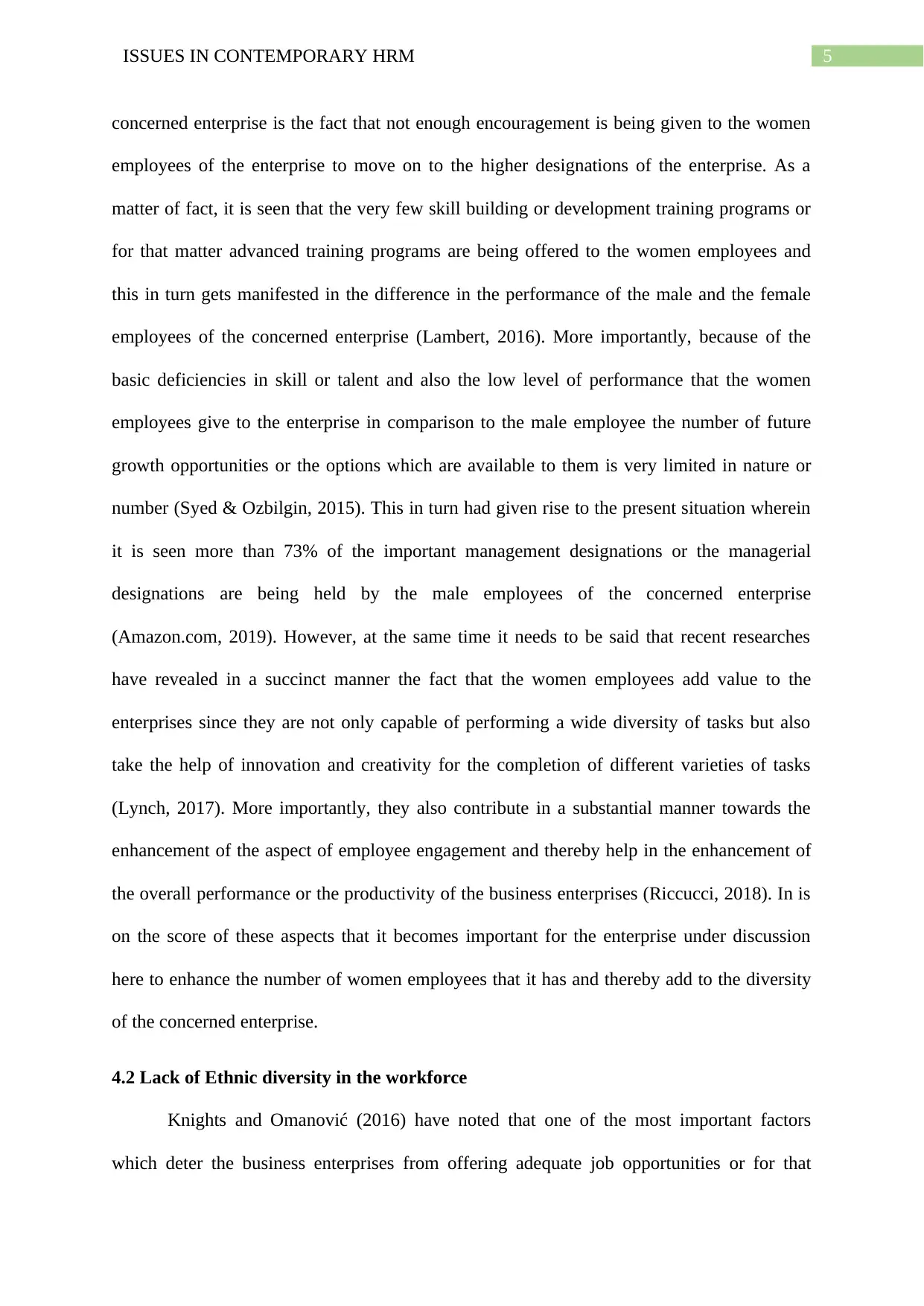
5ISSUES IN CONTEMPORARY HRM
concerned enterprise is the fact that not enough encouragement is being given to the women
employees of the enterprise to move on to the higher designations of the enterprise. As a
matter of fact, it is seen that the very few skill building or development training programs or
for that matter advanced training programs are being offered to the women employees and
this in turn gets manifested in the difference in the performance of the male and the female
employees of the concerned enterprise (Lambert, 2016). More importantly, because of the
basic deficiencies in skill or talent and also the low level of performance that the women
employees give to the enterprise in comparison to the male employee the number of future
growth opportunities or the options which are available to them is very limited in nature or
number (Syed & Ozbilgin, 2015). This in turn had given rise to the present situation wherein
it is seen more than 73% of the important management designations or the managerial
designations are being held by the male employees of the concerned enterprise
(Amazon.com, 2019). However, at the same time it needs to be said that recent researches
have revealed in a succinct manner the fact that the women employees add value to the
enterprises since they are not only capable of performing a wide diversity of tasks but also
take the help of innovation and creativity for the completion of different varieties of tasks
(Lynch, 2017). More importantly, they also contribute in a substantial manner towards the
enhancement of the aspect of employee engagement and thereby help in the enhancement of
the overall performance or the productivity of the business enterprises (Riccucci, 2018). In is
on the score of these aspects that it becomes important for the enterprise under discussion
here to enhance the number of women employees that it has and thereby add to the diversity
of the concerned enterprise.
4.2 Lack of Ethnic diversity in the workforce
Knights and Omanović (2016) have noted that one of the most important factors
which deter the business enterprises from offering adequate job opportunities or for that
concerned enterprise is the fact that not enough encouragement is being given to the women
employees of the enterprise to move on to the higher designations of the enterprise. As a
matter of fact, it is seen that the very few skill building or development training programs or
for that matter advanced training programs are being offered to the women employees and
this in turn gets manifested in the difference in the performance of the male and the female
employees of the concerned enterprise (Lambert, 2016). More importantly, because of the
basic deficiencies in skill or talent and also the low level of performance that the women
employees give to the enterprise in comparison to the male employee the number of future
growth opportunities or the options which are available to them is very limited in nature or
number (Syed & Ozbilgin, 2015). This in turn had given rise to the present situation wherein
it is seen more than 73% of the important management designations or the managerial
designations are being held by the male employees of the concerned enterprise
(Amazon.com, 2019). However, at the same time it needs to be said that recent researches
have revealed in a succinct manner the fact that the women employees add value to the
enterprises since they are not only capable of performing a wide diversity of tasks but also
take the help of innovation and creativity for the completion of different varieties of tasks
(Lynch, 2017). More importantly, they also contribute in a substantial manner towards the
enhancement of the aspect of employee engagement and thereby help in the enhancement of
the overall performance or the productivity of the business enterprises (Riccucci, 2018). In is
on the score of these aspects that it becomes important for the enterprise under discussion
here to enhance the number of women employees that it has and thereby add to the diversity
of the concerned enterprise.
4.2 Lack of Ethnic diversity in the workforce
Knights and Omanović (2016) have noted that one of the most important factors
which deter the business enterprises from offering adequate job opportunities or for that
⊘ This is a preview!⊘
Do you want full access?
Subscribe today to unlock all pages.

Trusted by 1+ million students worldwide
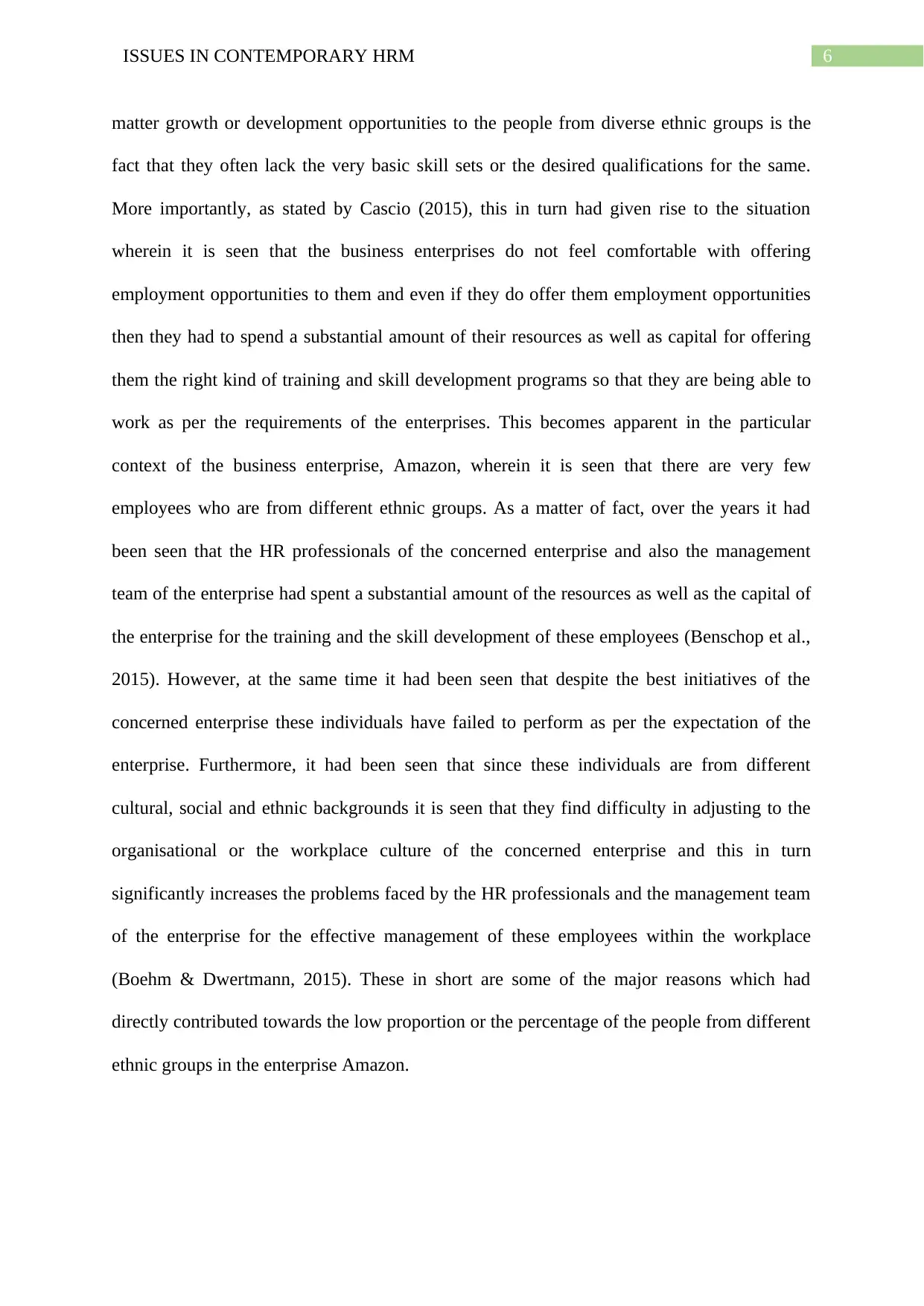
6ISSUES IN CONTEMPORARY HRM
matter growth or development opportunities to the people from diverse ethnic groups is the
fact that they often lack the very basic skill sets or the desired qualifications for the same.
More importantly, as stated by Cascio (2015), this in turn had given rise to the situation
wherein it is seen that the business enterprises do not feel comfortable with offering
employment opportunities to them and even if they do offer them employment opportunities
then they had to spend a substantial amount of their resources as well as capital for offering
them the right kind of training and skill development programs so that they are being able to
work as per the requirements of the enterprises. This becomes apparent in the particular
context of the business enterprise, Amazon, wherein it is seen that there are very few
employees who are from different ethnic groups. As a matter of fact, over the years it had
been seen that the HR professionals of the concerned enterprise and also the management
team of the enterprise had spent a substantial amount of the resources as well as the capital of
the enterprise for the training and the skill development of these employees (Benschop et al.,
2015). However, at the same time it had been seen that despite the best initiatives of the
concerned enterprise these individuals have failed to perform as per the expectation of the
enterprise. Furthermore, it had been seen that since these individuals are from different
cultural, social and ethnic backgrounds it is seen that they find difficulty in adjusting to the
organisational or the workplace culture of the concerned enterprise and this in turn
significantly increases the problems faced by the HR professionals and the management team
of the enterprise for the effective management of these employees within the workplace
(Boehm & Dwertmann, 2015). These in short are some of the major reasons which had
directly contributed towards the low proportion or the percentage of the people from different
ethnic groups in the enterprise Amazon.
matter growth or development opportunities to the people from diverse ethnic groups is the
fact that they often lack the very basic skill sets or the desired qualifications for the same.
More importantly, as stated by Cascio (2015), this in turn had given rise to the situation
wherein it is seen that the business enterprises do not feel comfortable with offering
employment opportunities to them and even if they do offer them employment opportunities
then they had to spend a substantial amount of their resources as well as capital for offering
them the right kind of training and skill development programs so that they are being able to
work as per the requirements of the enterprises. This becomes apparent in the particular
context of the business enterprise, Amazon, wherein it is seen that there are very few
employees who are from different ethnic groups. As a matter of fact, over the years it had
been seen that the HR professionals of the concerned enterprise and also the management
team of the enterprise had spent a substantial amount of the resources as well as the capital of
the enterprise for the training and the skill development of these employees (Benschop et al.,
2015). However, at the same time it had been seen that despite the best initiatives of the
concerned enterprise these individuals have failed to perform as per the expectation of the
enterprise. Furthermore, it had been seen that since these individuals are from different
cultural, social and ethnic backgrounds it is seen that they find difficulty in adjusting to the
organisational or the workplace culture of the concerned enterprise and this in turn
significantly increases the problems faced by the HR professionals and the management team
of the enterprise for the effective management of these employees within the workplace
(Boehm & Dwertmann, 2015). These in short are some of the major reasons which had
directly contributed towards the low proportion or the percentage of the people from different
ethnic groups in the enterprise Amazon.
Paraphrase This Document
Need a fresh take? Get an instant paraphrase of this document with our AI Paraphraser
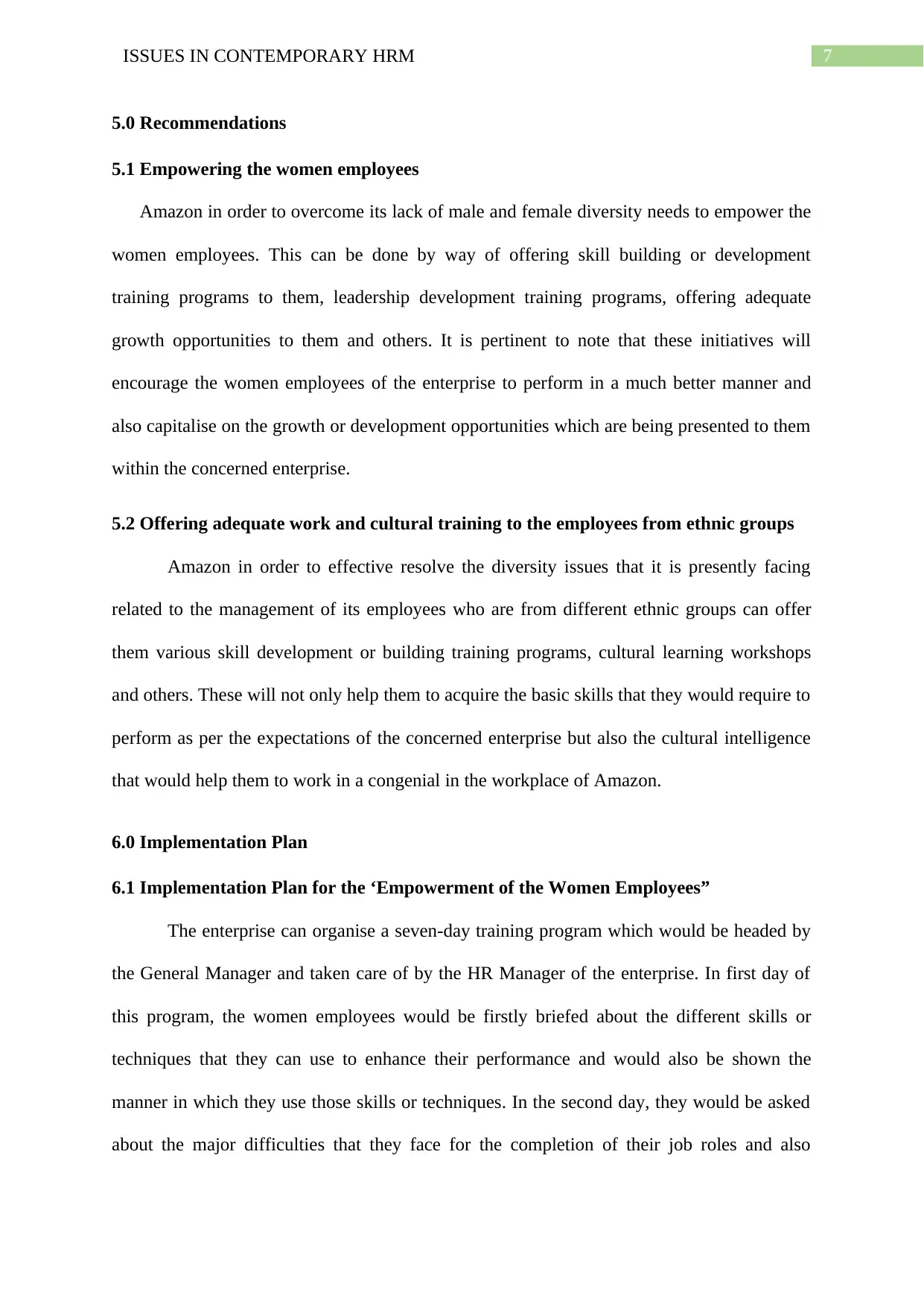
7ISSUES IN CONTEMPORARY HRM
5.0 Recommendations
5.1 Empowering the women employees
Amazon in order to overcome its lack of male and female diversity needs to empower the
women employees. This can be done by way of offering skill building or development
training programs to them, leadership development training programs, offering adequate
growth opportunities to them and others. It is pertinent to note that these initiatives will
encourage the women employees of the enterprise to perform in a much better manner and
also capitalise on the growth or development opportunities which are being presented to them
within the concerned enterprise.
5.2 Offering adequate work and cultural training to the employees from ethnic groups
Amazon in order to effective resolve the diversity issues that it is presently facing
related to the management of its employees who are from different ethnic groups can offer
them various skill development or building training programs, cultural learning workshops
and others. These will not only help them to acquire the basic skills that they would require to
perform as per the expectations of the concerned enterprise but also the cultural intelligence
that would help them to work in a congenial in the workplace of Amazon.
6.0 Implementation Plan
6.1 Implementation Plan for the ‘Empowerment of the Women Employees”
The enterprise can organise a seven-day training program which would be headed by
the General Manager and taken care of by the HR Manager of the enterprise. In first day of
this program, the women employees would be firstly briefed about the different skills or
techniques that they can use to enhance their performance and would also be shown the
manner in which they use those skills or techniques. In the second day, they would be asked
about the major difficulties that they face for the completion of their job roles and also
5.0 Recommendations
5.1 Empowering the women employees
Amazon in order to overcome its lack of male and female diversity needs to empower the
women employees. This can be done by way of offering skill building or development
training programs to them, leadership development training programs, offering adequate
growth opportunities to them and others. It is pertinent to note that these initiatives will
encourage the women employees of the enterprise to perform in a much better manner and
also capitalise on the growth or development opportunities which are being presented to them
within the concerned enterprise.
5.2 Offering adequate work and cultural training to the employees from ethnic groups
Amazon in order to effective resolve the diversity issues that it is presently facing
related to the management of its employees who are from different ethnic groups can offer
them various skill development or building training programs, cultural learning workshops
and others. These will not only help them to acquire the basic skills that they would require to
perform as per the expectations of the concerned enterprise but also the cultural intelligence
that would help them to work in a congenial in the workplace of Amazon.
6.0 Implementation Plan
6.1 Implementation Plan for the ‘Empowerment of the Women Employees”
The enterprise can organise a seven-day training program which would be headed by
the General Manager and taken care of by the HR Manager of the enterprise. In first day of
this program, the women employees would be firstly briefed about the different skills or
techniques that they can use to enhance their performance and would also be shown the
manner in which they use those skills or techniques. In the second day, they would be asked
about the major difficulties that they face for the completion of their job roles and also
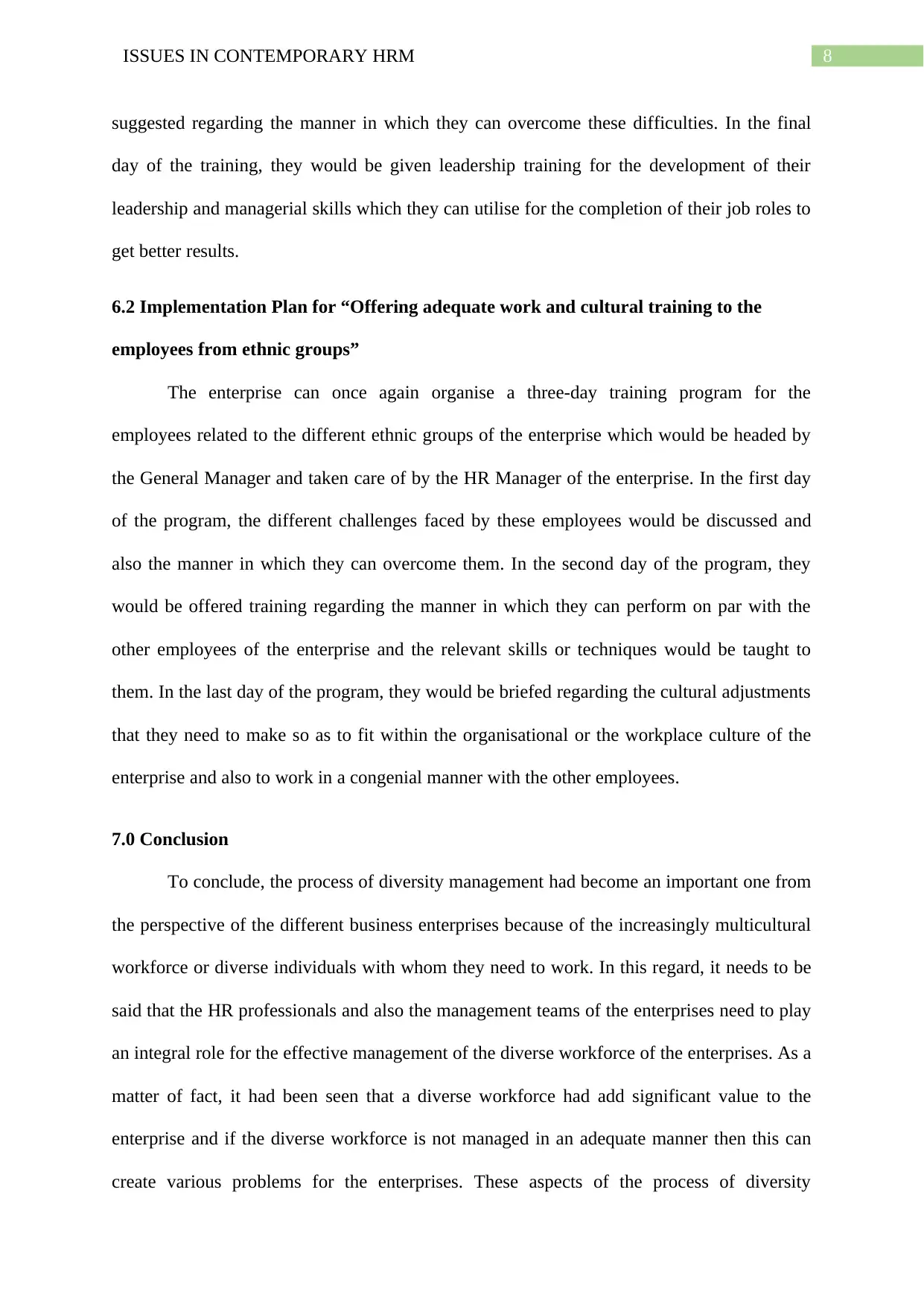
8ISSUES IN CONTEMPORARY HRM
suggested regarding the manner in which they can overcome these difficulties. In the final
day of the training, they would be given leadership training for the development of their
leadership and managerial skills which they can utilise for the completion of their job roles to
get better results.
6.2 Implementation Plan for “Offering adequate work and cultural training to the
employees from ethnic groups”
The enterprise can once again organise a three-day training program for the
employees related to the different ethnic groups of the enterprise which would be headed by
the General Manager and taken care of by the HR Manager of the enterprise. In the first day
of the program, the different challenges faced by these employees would be discussed and
also the manner in which they can overcome them. In the second day of the program, they
would be offered training regarding the manner in which they can perform on par with the
other employees of the enterprise and the relevant skills or techniques would be taught to
them. In the last day of the program, they would be briefed regarding the cultural adjustments
that they need to make so as to fit within the organisational or the workplace culture of the
enterprise and also to work in a congenial manner with the other employees.
7.0 Conclusion
To conclude, the process of diversity management had become an important one from
the perspective of the different business enterprises because of the increasingly multicultural
workforce or diverse individuals with whom they need to work. In this regard, it needs to be
said that the HR professionals and also the management teams of the enterprises need to play
an integral role for the effective management of the diverse workforce of the enterprises. As a
matter of fact, it had been seen that a diverse workforce had add significant value to the
enterprise and if the diverse workforce is not managed in an adequate manner then this can
create various problems for the enterprises. These aspects of the process of diversity
suggested regarding the manner in which they can overcome these difficulties. In the final
day of the training, they would be given leadership training for the development of their
leadership and managerial skills which they can utilise for the completion of their job roles to
get better results.
6.2 Implementation Plan for “Offering adequate work and cultural training to the
employees from ethnic groups”
The enterprise can once again organise a three-day training program for the
employees related to the different ethnic groups of the enterprise which would be headed by
the General Manager and taken care of by the HR Manager of the enterprise. In the first day
of the program, the different challenges faced by these employees would be discussed and
also the manner in which they can overcome them. In the second day of the program, they
would be offered training regarding the manner in which they can perform on par with the
other employees of the enterprise and the relevant skills or techniques would be taught to
them. In the last day of the program, they would be briefed regarding the cultural adjustments
that they need to make so as to fit within the organisational or the workplace culture of the
enterprise and also to work in a congenial manner with the other employees.
7.0 Conclusion
To conclude, the process of diversity management had become an important one from
the perspective of the different business enterprises because of the increasingly multicultural
workforce or diverse individuals with whom they need to work. In this regard, it needs to be
said that the HR professionals and also the management teams of the enterprises need to play
an integral role for the effective management of the diverse workforce of the enterprises. As a
matter of fact, it had been seen that a diverse workforce had add significant value to the
enterprise and if the diverse workforce is not managed in an adequate manner then this can
create various problems for the enterprises. These aspects of the process of diversity
⊘ This is a preview!⊘
Do you want full access?
Subscribe today to unlock all pages.

Trusted by 1+ million students worldwide

9ISSUES IN CONTEMPORARY HRM
management become apparent from the above analysis of the diversity management issues
faced by Amazon.
management become apparent from the above analysis of the diversity management issues
faced by Amazon.
Paraphrase This Document
Need a fresh take? Get an instant paraphrase of this document with our AI Paraphraser
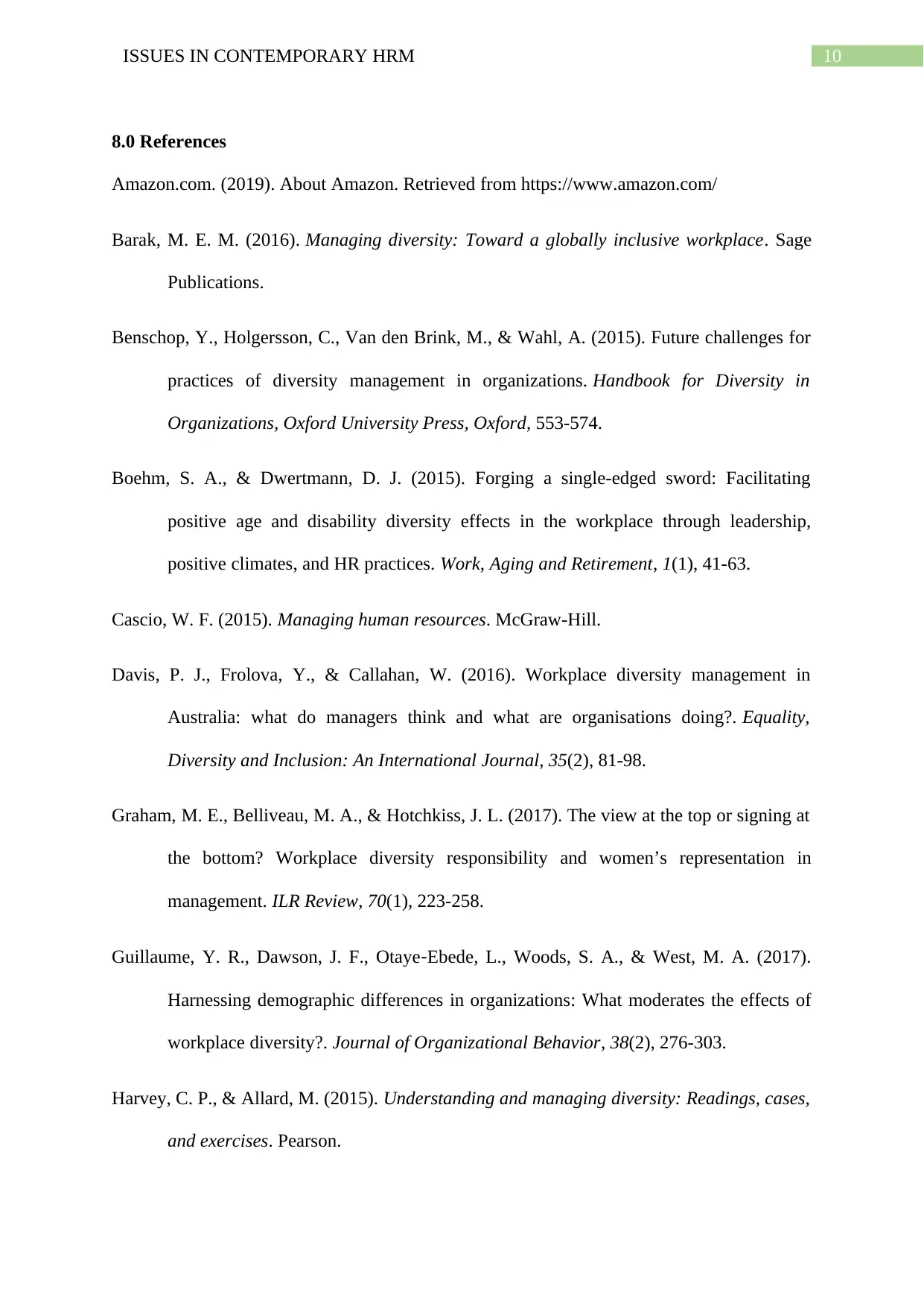
10ISSUES IN CONTEMPORARY HRM
8.0 References
Amazon.com. (2019). About Amazon. Retrieved from https://www.amazon.com/
Barak, M. E. M. (2016). Managing diversity: Toward a globally inclusive workplace. Sage
Publications.
Benschop, Y., Holgersson, C., Van den Brink, M., & Wahl, A. (2015). Future challenges for
practices of diversity management in organizations. Handbook for Diversity in
Organizations, Oxford University Press, Oxford, 553-574.
Boehm, S. A., & Dwertmann, D. J. (2015). Forging a single-edged sword: Facilitating
positive age and disability diversity effects in the workplace through leadership,
positive climates, and HR practices. Work, Aging and Retirement, 1(1), 41-63.
Cascio, W. F. (2015). Managing human resources. McGraw-Hill.
Davis, P. J., Frolova, Y., & Callahan, W. (2016). Workplace diversity management in
Australia: what do managers think and what are organisations doing?. Equality,
Diversity and Inclusion: An International Journal, 35(2), 81-98.
Graham, M. E., Belliveau, M. A., & Hotchkiss, J. L. (2017). The view at the top or signing at
the bottom? Workplace diversity responsibility and women’s representation in
management. ILR Review, 70(1), 223-258.
Guillaume, Y. R., Dawson, J. F., Otaye‐Ebede, L., Woods, S. A., & West, M. A. (2017).
Harnessing demographic differences in organizations: What moderates the effects of
workplace diversity?. Journal of Organizational Behavior, 38(2), 276-303.
Harvey, C. P., & Allard, M. (2015). Understanding and managing diversity: Readings, cases,
and exercises. Pearson.
8.0 References
Amazon.com. (2019). About Amazon. Retrieved from https://www.amazon.com/
Barak, M. E. M. (2016). Managing diversity: Toward a globally inclusive workplace. Sage
Publications.
Benschop, Y., Holgersson, C., Van den Brink, M., & Wahl, A. (2015). Future challenges for
practices of diversity management in organizations. Handbook for Diversity in
Organizations, Oxford University Press, Oxford, 553-574.
Boehm, S. A., & Dwertmann, D. J. (2015). Forging a single-edged sword: Facilitating
positive age and disability diversity effects in the workplace through leadership,
positive climates, and HR practices. Work, Aging and Retirement, 1(1), 41-63.
Cascio, W. F. (2015). Managing human resources. McGraw-Hill.
Davis, P. J., Frolova, Y., & Callahan, W. (2016). Workplace diversity management in
Australia: what do managers think and what are organisations doing?. Equality,
Diversity and Inclusion: An International Journal, 35(2), 81-98.
Graham, M. E., Belliveau, M. A., & Hotchkiss, J. L. (2017). The view at the top or signing at
the bottom? Workplace diversity responsibility and women’s representation in
management. ILR Review, 70(1), 223-258.
Guillaume, Y. R., Dawson, J. F., Otaye‐Ebede, L., Woods, S. A., & West, M. A. (2017).
Harnessing demographic differences in organizations: What moderates the effects of
workplace diversity?. Journal of Organizational Behavior, 38(2), 276-303.
Harvey, C. P., & Allard, M. (2015). Understanding and managing diversity: Readings, cases,
and exercises. Pearson.
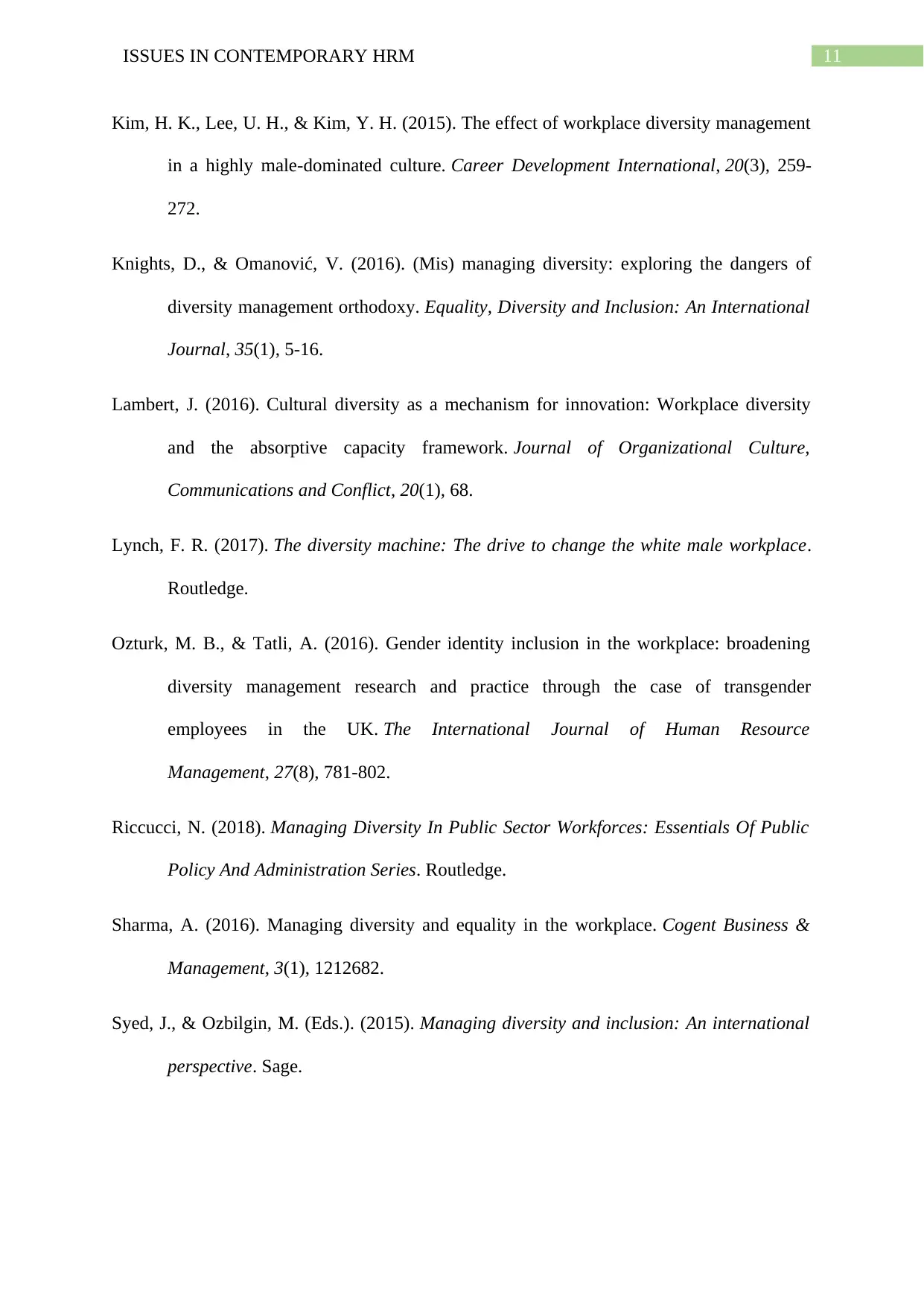
11ISSUES IN CONTEMPORARY HRM
Kim, H. K., Lee, U. H., & Kim, Y. H. (2015). The effect of workplace diversity management
in a highly male-dominated culture. Career Development International, 20(3), 259-
272.
Knights, D., & Omanović, V. (2016). (Mis) managing diversity: exploring the dangers of
diversity management orthodoxy. Equality, Diversity and Inclusion: An International
Journal, 35(1), 5-16.
Lambert, J. (2016). Cultural diversity as a mechanism for innovation: Workplace diversity
and the absorptive capacity framework. Journal of Organizational Culture,
Communications and Conflict, 20(1), 68.
Lynch, F. R. (2017). The diversity machine: The drive to change the white male workplace.
Routledge.
Ozturk, M. B., & Tatli, A. (2016). Gender identity inclusion in the workplace: broadening
diversity management research and practice through the case of transgender
employees in the UK. The International Journal of Human Resource
Management, 27(8), 781-802.
Riccucci, N. (2018). Managing Diversity In Public Sector Workforces: Essentials Of Public
Policy And Administration Series. Routledge.
Sharma, A. (2016). Managing diversity and equality in the workplace. Cogent Business &
Management, 3(1), 1212682.
Syed, J., & Ozbilgin, M. (Eds.). (2015). Managing diversity and inclusion: An international
perspective. Sage.
Kim, H. K., Lee, U. H., & Kim, Y. H. (2015). The effect of workplace diversity management
in a highly male-dominated culture. Career Development International, 20(3), 259-
272.
Knights, D., & Omanović, V. (2016). (Mis) managing diversity: exploring the dangers of
diversity management orthodoxy. Equality, Diversity and Inclusion: An International
Journal, 35(1), 5-16.
Lambert, J. (2016). Cultural diversity as a mechanism for innovation: Workplace diversity
and the absorptive capacity framework. Journal of Organizational Culture,
Communications and Conflict, 20(1), 68.
Lynch, F. R. (2017). The diversity machine: The drive to change the white male workplace.
Routledge.
Ozturk, M. B., & Tatli, A. (2016). Gender identity inclusion in the workplace: broadening
diversity management research and practice through the case of transgender
employees in the UK. The International Journal of Human Resource
Management, 27(8), 781-802.
Riccucci, N. (2018). Managing Diversity In Public Sector Workforces: Essentials Of Public
Policy And Administration Series. Routledge.
Sharma, A. (2016). Managing diversity and equality in the workplace. Cogent Business &
Management, 3(1), 1212682.
Syed, J., & Ozbilgin, M. (Eds.). (2015). Managing diversity and inclusion: An international
perspective. Sage.
⊘ This is a preview!⊘
Do you want full access?
Subscribe today to unlock all pages.

Trusted by 1+ million students worldwide
1 out of 12
Related Documents
Your All-in-One AI-Powered Toolkit for Academic Success.
+13062052269
info@desklib.com
Available 24*7 on WhatsApp / Email
![[object Object]](/_next/static/media/star-bottom.7253800d.svg)
Unlock your academic potential
Copyright © 2020–2025 A2Z Services. All Rights Reserved. Developed and managed by ZUCOL.




